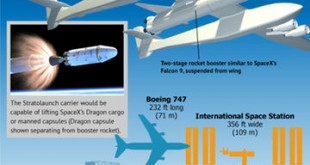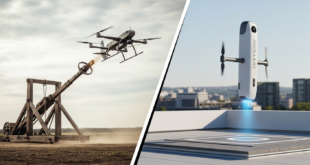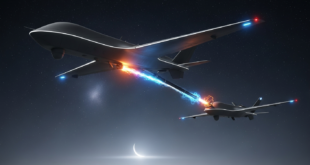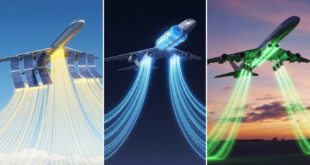The Cyborg Revolution: Insect Robotics Redefining Surveillance, Agriculture & Medicine Explore how insect-robot hybrids are transforming fields from agriculture to warfare by bringing the power of evolution into engineering. The convergence of biology and robotics has given rise to a new generation of machines that blur the line between organism …
Read More »Distributed Propulsion Systems: Revolutionizing Efficiency and Performance in Modern Aviation
Distributed Propulsion Systems: Redefining Efficiency, Control, and Sustainability in Modern Flight A new era of aviation is emerging — where dozens of intelligent electric propulsors work in harmony to create cleaner, quieter, and more efficient aircraft designs for both civil and defense applications. In recent years, the aerospace industry has …
Read More »ULTRA: The U.S. Air Force’s Low-Cost, Long-Endurance ISR Drone Takes Flight
In a move that reflects a growing shift toward affordability and endurance in defense technology, the U.S. Air Force has officially taken flight with ULTRA—short for Unmanned Long-Endurance Tactical Reconnaissance Aircraft. This next-generation drone is designed to deliver powerful intelligence, surveillance, and reconnaissance (ISR) capabilities without the high operational costs …
Read More »Space Planes: The Next Frontier in Ultrafast Space Transportation, Satellite Launches, Prompt Global Strike, and Space Security
Space Planes: The Next Frontier in Ultrafast Space Transportation and Defense Operations Revolutionary space planes are merging aviation and orbital flight, unlocking ultrafast transport, on-demand satellite launches, and the next phase of global defense innovation. Introduction: The Dual-Nature Revolution Space planes—hybrid vehicles capable of soaring through Earth’s atmosphere and maneuvering …
Read More »DARPA’s AWARE Program: A Leap Forward with Light Activated Drugs in Warfighter Alertness Post-Sleep Deprivation
DARPA’s AWARE Program: Light-Activated Drugs to Keep Warfighters Alert Without the Crash DARPA’s AWARE initiative pioneers photopharmacology—using near-infrared light to activate smart drugs that boost alertness on demand, redefining cognitive performance in defense and beyond. We’ve all experienced those grueling nights – facing a tight deadline, pulling an all-nighter, and …
Read More »Revolutionizing VTOL Warfare: DARPA’s ANCILLARY Program and the Future of Infrastructure-Free UAS
Revolutionizing VTOL Warfare: DARPA’s ANCILLARY Program and the Future of Infrastructure-Free UAS DARPA’s ANCILLARY program is redefining drone warfare with VTOL, hybrid-electric propulsion, and infrastructure-free operations — a game-changer for naval and expeditionary missions. The U.S. Defense Advanced Research Projects Agency (DARPA) is accelerating its vision for next-generation vertical takeoff …
Read More »The Future of Air-to-Air Refueling: Advancements in Automation, Drones, and Beyond
Air-to-Air Refueling 2040: The Backbone of Future Aerial DominanceAI-driven tankers, stealth designs, and drone-to-drone refueling are transforming airpower into a seamless global ecosystem. Air-to-air refueling (AAR) remains a cornerstone of modern military aviation, enabling aircraft to extend their operational range, endurance, and mission flexibility. As global conflicts evolve and airspaces …
Read More »Next-Gen Propulsion Systems for Small and Micro UAVs: Powering the Future of Aerial Innovation
Next-Gen Propulsion Systems for Small and Micro UAVs: Powering the Future of Aerial Innovation From hydrogen fuel cells to AI-driven tri-source hybrids, advanced propulsion technologies are redefining endurance, stealth, and mission flexibility for the next generation of UAVs. The rapid evolution of small unmanned aerial vehicles (SUAVs) and micro air …
Read More »DARPA’s XQ-73 SHEPARD Program: A Revolutionary Hybrid Electric Propulsion Aircraft
Introduction The Defense Advanced Research Projects Agency (DARPA) has unveiled an ambitious new initiative—the Series Hybrid Electric Propulsion AiRcraft Demonstration (SHEPARD) program, designated as the XQ-73. This “X-prime” program builds upon previous advancements from the Air Force Research Laboratory (AFRL) and Intelligence Advanced Research Projects Activity (IARPA) under the Great …
Read More »Agile Engineering is the Future of Aerospace Design and Production
Agile Engineering: Accelerating Aerospace Innovation for the Future Agile Engineering is transforming aerospace by enabling rapid prototyping, real-time testing, and faster time-to-market in space and aviation technology. The aerospace industry, long defined by its meticulous adherence to rigid timelines and waterfall methodologies, is undergoing a seismic shift. As demand for …
Read More » International Defense Security & Technology Your trusted Source for News, Research and Analysis
International Defense Security & Technology Your trusted Source for News, Research and Analysis







